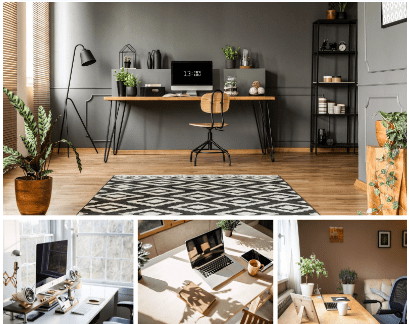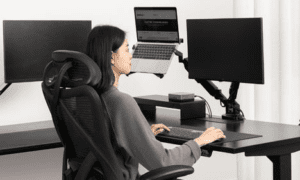Ergonomically designed offices are supposed to be the new age way of office buildings, but they have been around for some time now. An ergonomically designed office can reduce back, neck and shoulder pain by up to 70%.
But not all work-from-home offices are ergonomically designed; despite being linked with reduced back and neck pain, they lack a professional touch. Additionally, creating a comfortable home office can be important for a workspace that supports great work.
If you work from home, there’s no reason to let your office become a mess of papers, books and old takeout containers. In fact, if you’re going to spend most of your day at home, you should make sure it’s a pleasant place to be.
Creating an office with work-from-home ergonomics doesn’t have to be time-consuming or expensive.
Whether you’re starting your first home office or thinking about an upgrade, here are 3 ways that you can create an ergonomic work-from-home office to ensure a comfortable, efficient and healthy working environment.
1. Create a dedicated home office space.
Plan your space. Create a dedicated home office by planning your space and setting up your furniture accordingly. Consider how much room you need for each piece of furniture — and how much storage you’ll need for files and other items.
Set up your desk so that it faces a window or another source of natural light. The natural light will help keep you alert during long days at the computer, which can prevent eye strain, fatigue and headaches.
To maximize sunlight exposure in winter months when there isn’t enough natural light coming in through windows at certain times of day, consider using artificial lightings like lamps or overhead lights with daylight bulbs that mimic natural light.
Make sure you have access to all the tools you need while sitting at your desk. If you have limited space in your home office, consider getting rid of bulky items like printers or scanners that aren’t essential for everyday use so that there’s more room
2. Invest in the proper office furniture.
Buy quality equipment. The right office furniture can make all the difference in helping you stay comfortable while working at home.
Consider buying chairs with adjustable seats and backs, so that you can find the right height and position for your body type. Set up a comfortable chair with good lumbar support and armrests that can be modified so you aren’t slouching or reaching for things.
Also make sure to use a solid desk or table that isn’t wobbly and has enough room for all of your items — keyboard, mouse, paper — without crowding around them or having them stacked on top of each other.
Make sure your monitor is set at eye level so you’re looking straight ahead when working; this will reduce neck strain and eye fatigue over time.
This is the most important thing that you need to do when setting up your own workspace. It makes sense to invest in ergonomic furniture because it helps prevent injuries and makes you feel more comfortable when working for long hours.
If you want to make sure that your chairs, desks and tables are ergonomically designed, then it’s best to go for those with adjustable features such as height and tilt.
This way, they’ll be able to fit any user regardless of their height or weight. Also, ensure that they’re made from quality materials such as metal or wood instead of plastic which can be harmful over time.
3. Create a comfortable, non-distracting work environment.
This is connected with planning your workspace as having a dedicated area to work will make all the difference. Try not to work in bed if possible; use a desk instead. Your body will thank you later.
Also, you need to make sure there is adequate lighting, temperature control and soundproofing so that you aren’t distracted by outside noise or distractions from other people in your house.
You can even improve your focus and productivity with a variety of scents using diffusers or scented candles. Find out what works for you and what gets you into the zone so that working for long hours won’t be as punishing as it is on your mind and body.
Key Takeaway
Using ergonomic principles to create an ergonomic work-from-home office doesn’t have to be a difficult task. There are a number of easy strategies you can undertake to make your home office more comfortable.
Following these strategies and creating this type of environment can help you mitigate risks associated with poor posture, neck, and spinal discomfort, and other problems associated with sitting at a desk for extended periods of time.
An ergonomic work-from-home environment can help you maintain good health and get more work done. We hope that these tips will help you create a comfortable and efficient home office.

































